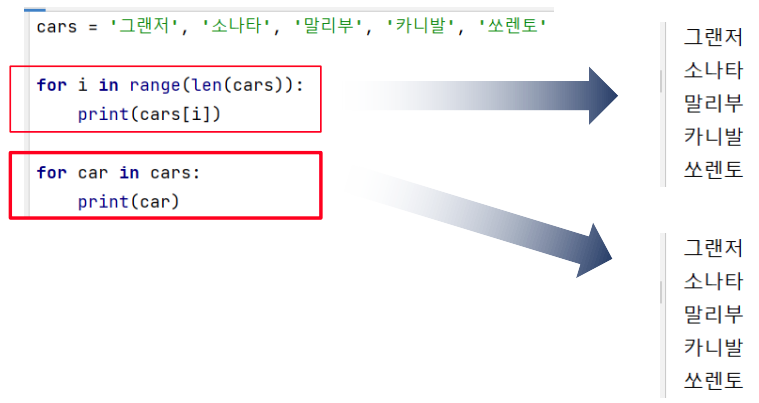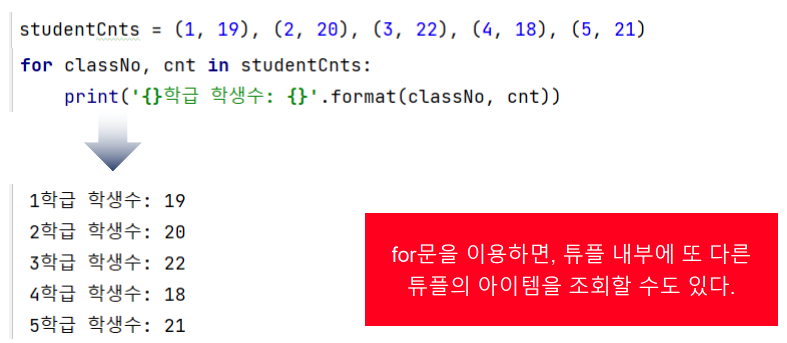RUBY
튜플 for문을 이용한 조회(파이썬) 본문
튜플 for문을 이용한 조회
for문을 이용하면 튜플의 아이템을 자동으로 참조할 수 있다.

for문을 이용하면 튜플의 아이템을 자동으로 참조할 수 있다.

아래 표와 튜플을 이용해서 학급별 학생 수와 전체 학생 수 그리고 평균 학생수를 출력해보자

studentCnts = (1, 18), (2, 19), (3, 23), (4, 21), (5, 20), (6, 22), (7, 17)
sum = 0
avg = 0
for classNo, cnt in studentCnts:
print('{}학급 학생수: {}명'.format(classNo, cnt))
sum += cnt
print('전체 학생 수: {}명'.format(sum))
print('평균 학생 수: {}명'.format(sum / len(studentCnts)))1학급 학생수: 18명
2학급 학생수: 19명
3학급 학생수: 23명
4학급 학생수: 21명
5학급 학생수: 20명
6학급 학생수: 22명
7학급 학생수: 17명
전체 학생 수: 140명
평균 학생 수: 20.0명
for문과 if문을 이용해서 과락 과목 출력하기
minScore = 60
scores = (
('국어', 58),
('영어', 77),
('수학', 89),
('과학', 99),
('국사', 50))
for item in scores:
if item[1] < minScore:
print('과락 과목: {}, 점수: {}'.format(item[0], item[1]))과락 과목: 국어, 점수: 58
과락 과목: 국사, 점수: 50
for문과 if문을 이용해서 과락 과목 출력하기
minScore = 60
scores = (
('국어', 58),
('영어', 77),
('수학', 89),
('과학', 99),
('국사', 50))
for subject, score in scores:
if score < minScore:
print('과락 과목: {}, 점수: {}'.format(subject, score))minScore = 60
scores = (
('국어', 58),
('영어', 77),
('수학', 89),
('과학', 99),
('국사', 50))
for subject, score in scores:
if score >= minScore: continue
print('과락 과목: {}, 점수: {}'.format(subject, score))
사용자가 국어, 영어, 수학, 과학, 국사 점수를 입력하면 과락 과목과 점수를 출력하는 프로그램을 만들어보자.
minScore = 60
korScore = int(input('국어 점수: '))
engScore = int(input('영어 점수: '))
matScore = int(input('수학 점수: '))
sciScore = int(input('과학 점수: '))
hisScore = int(input('국사 점수: '))
scores = (
('국어', korScore),
('영어', engScore),
('수학', matScore),
('과학', sciScore),
('국사', hisScore))
for subject, score in scores:
if score < minScore:
print('과락 과목: {}, 점수: {}'.format(subject, score))국어 점수: 80
영어 점수: 59
수학 점수: 66
과학 점수: 70
국사 점수: 50
과락 과목: 영어, 점수: 59
과락 과목: 국사, 점수: 50
아래의 표와 튜플을 이용해서 학급 학생 수가 가장 작은 학급과 가장 많은 학급을 출력해보자
studentCnts = ((1, 18), (2, 19), (3, 23), (4, 21), (5, 20), (6, 22), (7, 17))
minClassNo = 0
maxClassNo = 0
minCnt = 0
maxCnt = 0
for classNo, cnt in studentCnts:
if minCnt == 0 or minCnt > cnt:
minClassNo = classNo
minCnt = cnt
if maxCnt < cnt:
maxClassNo = classNo
maxCnt = cnt
print('학생 수가 가장 적은 학급(학생수): {}학급({}명)'.format(minClassNo, minCnt))
print('학생 수가 가장 많은 학급(학생수): {}학급({}명)'.format(maxClassNo, maxCnt))학생 수가 가장 적은 학급(학생수): 7학급(17명)
학생 수가 가장 많은 학급(학생수): 3학급(23명)
'프로그래밍 언어 > Python' 카테고리의 다른 글
| 딕셔너리(Dictionary)(파이썬) (0) | 2023.01.23 |
|---|---|
| 튜플 while문을 이용한 조회(파이썬) (0) | 2023.01.23 |
| 튜플 정렬(파이썬) (0) | 2023.01.23 |
| 리스트와 튜플 차이점(파이썬) (0) | 2023.01.23 |
| 튜플 슬라이싱[n:m](파이썬) (0) | 2023.01.23 |
Comments




